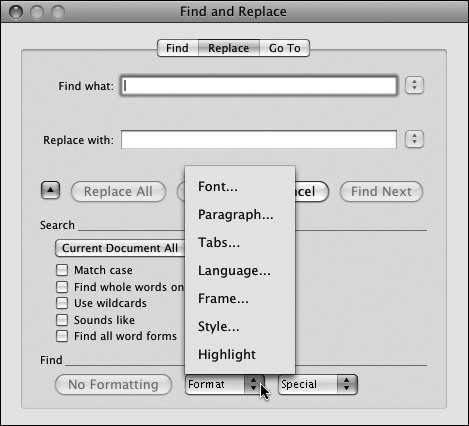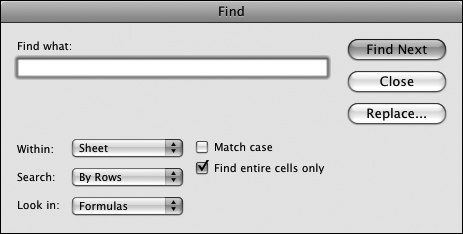You can use the Find and Replace features to locate or change information in any Office file. With minor variations, the Find and Replace features work the same in all of the Office 2008 for Mac programs:
You use the Find feature to search for information, such as a character, word, phrase, format, or style.
You use the Replace feature to replace instances of the search term or format with other terms or formats.
Word 2008 for Mac provides significantly more search options and replace options than other Office 2008 programs. Clicking Find on the Edit menu, or pressing Command+F, displays the Find page of the Find And Replace dialog box.

You can move between instances of specified text in a document, or highlight all instances in the document.
After you enter the search term you want to locate in the Find What box, you can click Find Next to locate and select the next occurrence of that text, or select the Highlight All Items Found In check box and then click Find All to highlight all occurrences of the search term in the document.
Tip
If you find an error in a document while conducting a search, you can edit the document content without closing the Find And Replace dialog box. Simply click the document, make the change, and then click the Find And Replace dialog box to reactivate it.
You can specify additional search options by clicking the Expand Search button.
In the expanded Find And Replace dialog box, you can select any or all of the check boxes:
Select the Match Case check box to match the capitalization of the search term as you have entered it in the Find What box.
Select the Find Whole Words Only check box to find only whole-word occurrences of the Find What text.
If you want to check that your usage of two similar words, such as effect and affect, is correct, select the Use Wildcards check box and then enter a wildcard character in the Find What box to locate variable information. The two most common wildcard characters are:
The ? (question mark), which stands for any single character in this location.
The * (asterisk), which stands for any number of characters in this location.
Select the Sounds Like check box to find occurrences of the search term that sound the same but are spelled differently, such as there and their.
Select the Find All Word Forms check box to find multiple forms of the search term, such as plan, planned, and planning.
By using the lists in the Search and Find areas, you can:
Guide the scope and direction of the search.
Include special characters such as paragraph marks, tab characters, or graphics in the search term, by selecting the character from the Special list. Doing so inserts a special code identifying the character (such as ^p for paragraph mark) in the Find What box.
Specify the format of the search term, or indicate that you want to search for any text formatted with a specific character format, paragraph format, or style, by displaying the Format list and then clicking the type of formatting you want to search for. Options include Font, Paragraph, Tabs, Language, Frame, Style, and Highlight.
If you know that you want to substitute one word or phrase for another, you can use the Replace feature to find each occurrence of the text you want to change and replace it with different text. Clicking the Replace button at the top of the Find And Replace dialog box, or clicking Replace on the Edit menu, displays the Replace page of the Find And Replace dialog box, which is the same as the Find page with an additional Replace With text box.
On the Replace page, you can do the following:
Click Find Next to locate and select the next occurrence of the search term.
Click Replace to replace the selected occurrence of the search term with the replacement specified in the Replace With box and move to the next occurrence.
Click Replace All to replace all occurrences with the specified replacement.
In addition to searching for words and phrases, in Word 2008, you can search for a specific type of character, paragraph, tab, language, frame, or style formatting, or search for highlighting, and replace the specified formatting with different formatting.
To replace a format with a different format:
On the Edit menu, click Replace (or press Shift+Command+H).
The Find And Replace dialog box opens, displaying the Replace page.
Click to position the insertion point in the Find what box, and then click the Expand button to display additional search options. In the Find area, in the Format list, click the type of formatting you want to search for.
In the Find dialog box that opens, specify the formatting you want to find.
Click OK in the Find dialog box. Move the insertion point to the Replace with text box and repeat step 2, specifying the formatting you want to substitute for the Find What formatting. Then click OK in the Replace dialog box.
Click Replace All to replace every instance of the Find What formatting with the Replace With formatting, or click Find Next to search for the first occurrence of the format, and then click Replace to replace that one instance and move to the next.
The Find and Replace functions in Excel 2008 for Mac are designed to locate information in worksheet cells. Clicking Find on the Edit menu or pressing Command+F displays the Find dialog box.
You can restrict the search operation to the current worksheet or search the entire workbook, specify the direction of the search (by rows or by columns), and specify what aspect of each cell will be evaluated (formulas, values, or comments). You have the options of matching the case of the search term as you enter it in the Find What box, and of specifying whether to find all cells containing the search term or only those cells that contain nothing but the search term.
Clicking Replace in the Find dialog box or on the Edit menu displays the Replace dialog box, in which you can specify a replacement term.
PowerPoint 2008 for Mac provides the following search and replace options:
You can locate specific text within a presentation from the Find dialog box, which you open by clicking Find on the Edit menu or pressing Command+F. You can specify whether PowerPoint should locate matches with the exact capitalization or case—that is, if you specify person, PowerPoint will not locate Person—and whether it should locate matches for the entire text—that is, if you specify person, PowerPoint will not locate personal.
You can replace specific text with other text from the Replace dialog box, which you open by clicking Replace in the Find dialog box or by clicking Replace on the Edit menu. You can approve the replacement of each instance of the search term, or replace all instances of the search term in the presentation in one operation. You have the options of matching the case of the search term and of excluding variations on the search term.
You can change all instances of a font within a presentation to another font. You can specify only the font name, not the size, weight, or any other attribute.






